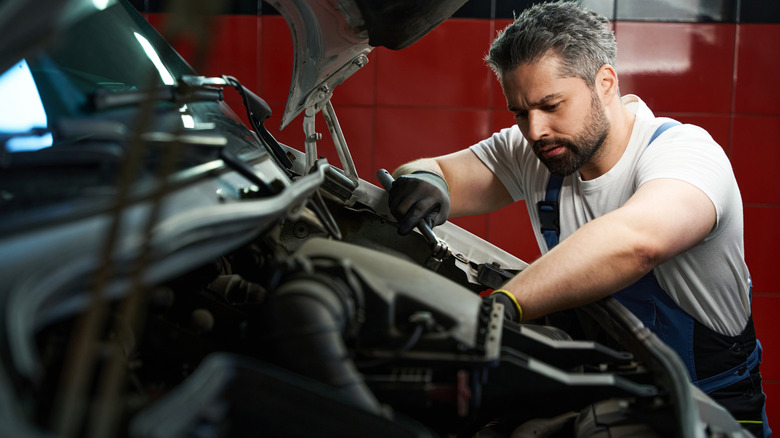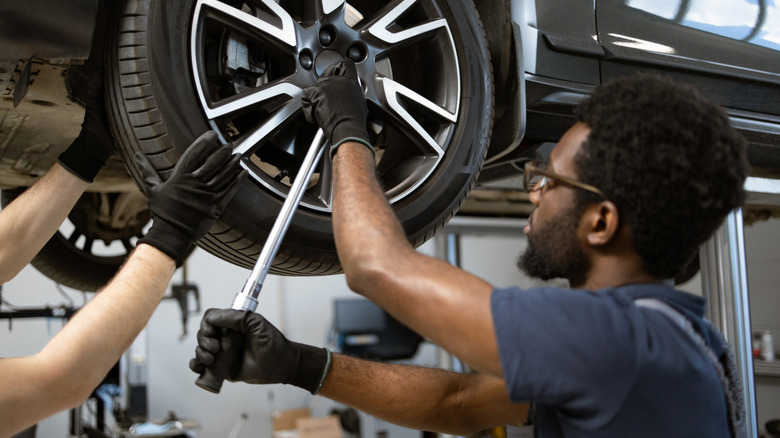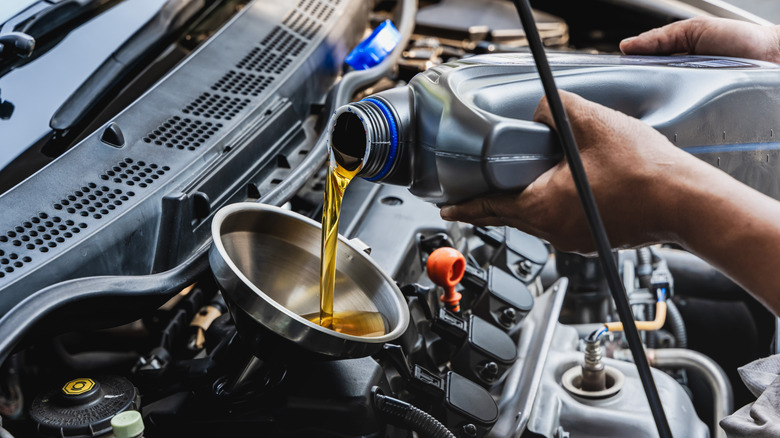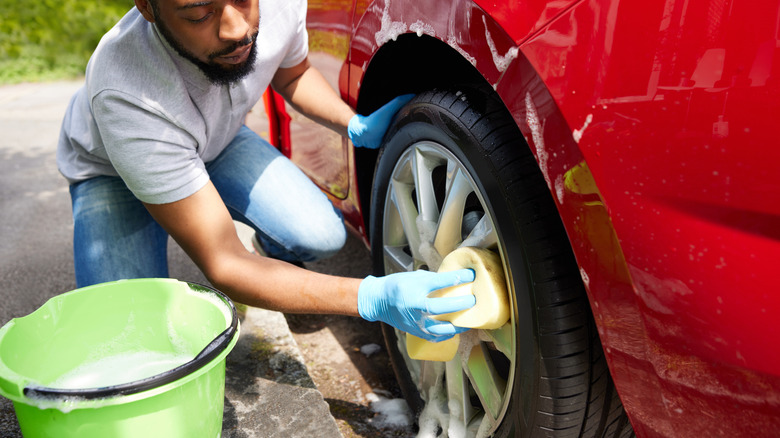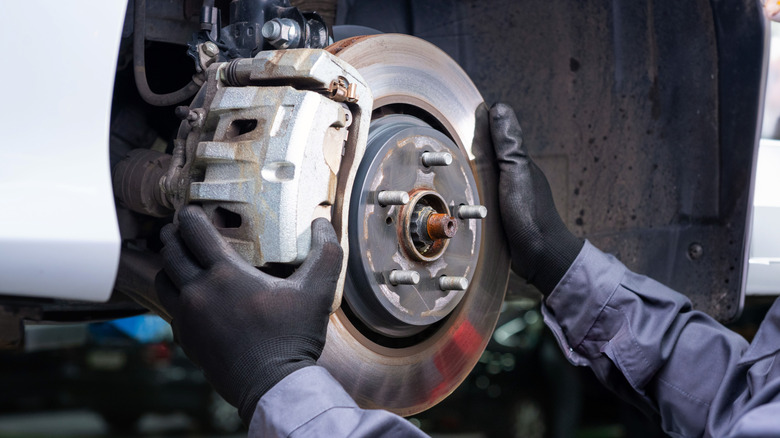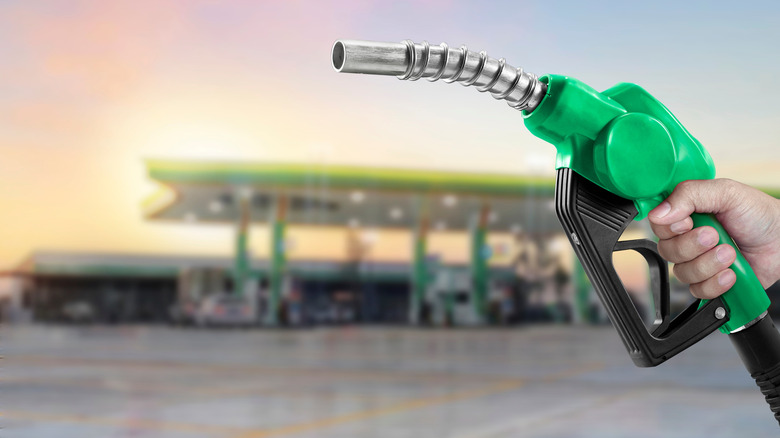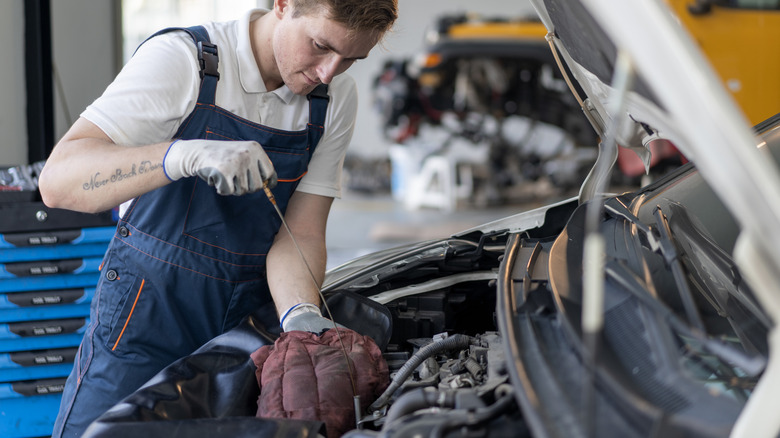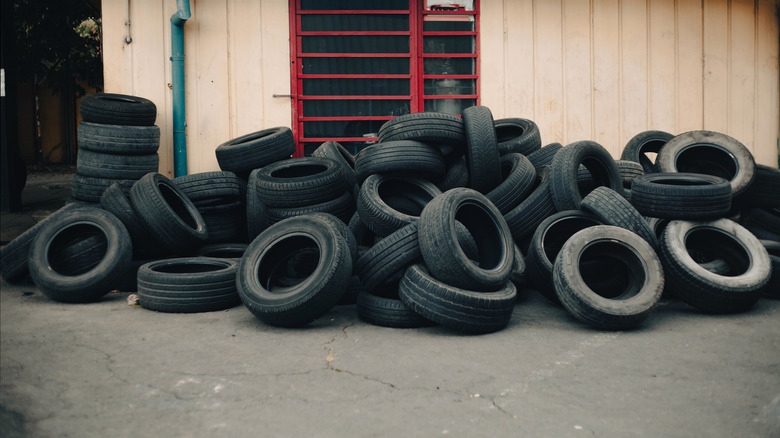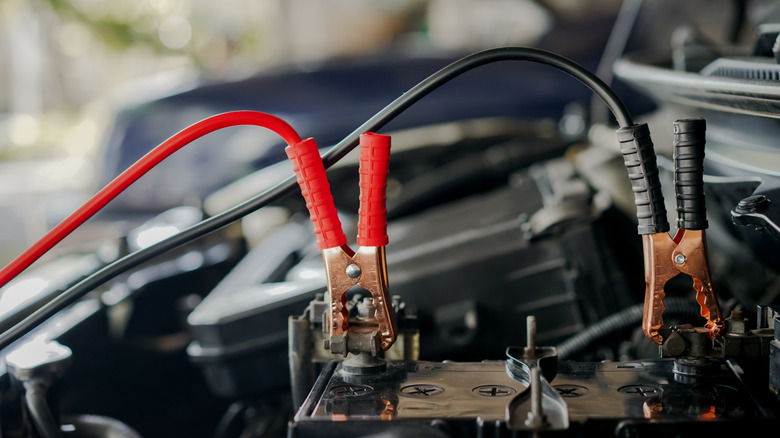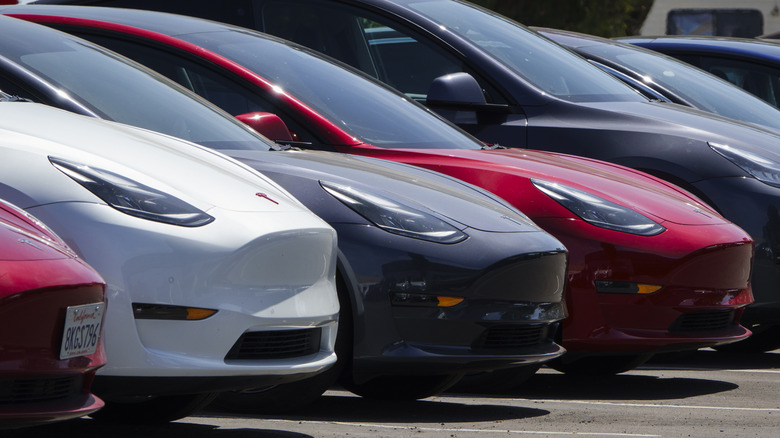10 Car Maintenance Myths You Should Stop Believing
Buying a car for the first time often results in a barrage of advice and tips from family members, friends, and colleagues. While some of this advice will be helpful, other purported tips and tricks to keep your car running well might actually have the opposite effect. Following bad advice can not only affect the overall lifespan of your car but can also potentially leave you with big bills later down the line. Other tips can leave you with a lighter wallet but have no beneficial effect on your car.
Working out which tips are worth listening to and which are worth discarding isn't always an easy task, and it's important to remember that what might be helpful for one person and their driving needs might not be helpful for another. However, there are some tips that are almost always worth ignoring. These car maintenance myths are worth knowing about, if nothing else, so that you can safely ignore them if someone tries to suggest them to you in the future.
False: You can rotate all tires in any pattern
While rotating tires can help you prolong their life by ensuring that they wear more evenly, it's important to make sure that you rotate them in a way that doesn't affect their capability. According to Michelin, it's best to rotate tires every 6,000-8,000 miles. Since the average driver in America covers around 13,500 miles annually, that equates to around once every six months.
Rotating your tires might be a good thing for their lifespan, but rotating them incorrectly can significantly impact their performance. Some tires feature symmetrical patterns, and these tires can be rotated to any corner of the car, assuming the front and rear tires are the same size. However, other tires feature asymmetric or directional patterns, which means they'll need to be rotated in a certain direction in order to perform as well as possible.
Asymmetric tires will have an arrow on the sidewall that displays their direction of rotation and one sidewall of the tire will be labeled as the "outside." These tires can still be rotated, but only laterally — in other words, they can be moved from the front to the rear of a car and vice versa, but only on the same side of the car. If you're unsure about the correct way to rotate your tires, it's best to take your car to a shop, as they'll be able to determine which pattern of rotation is best.
False: You need to change your oil every 3,000 miles
The best interval to change your oil will vary based on the car you drive and the type of driving you do, but it shouldn't need to be as frequently as every 3,000 miles. When in doubt, it's best to follow the schedule recommended by your car's manufacturer, which can be found in the owner's manual. Changing your oil more frequently than necessary won't have any negative effects, but it means you'll be spending money that you don't need to spend. Depending on the make and model of your car, most manufacturers will probably recommend changing the oil every 7,500-10,000 miles. Depending on how far you drive in a year, that could be anywhere between six and 12 months between replacements.
Some drivers might benefit from changing their oil more frequently than the manufacturer recommends. Drivers who do lots of short trips should be particularly careful, as these trips can significantly impact the expected life of the oil. Driving in dusty areas can also lead to debris getting into your car's engine faster, so more frequent oil changes are probably advisable. However, for most people, following the manufacturer's recommendations is the best course of action.
False: Tire pressures don't matter as long as they're inflated
If a tire looks like it's inflated correctly, it's easy to assume that must mean that it is indeed inflated correctly. However, looks can be deceiving, so it's important to keep an eye on your tire pressures even if there isn't anything visibly wrong with them. In a study, the NHTSA estimated that around 28% of American drivers have at least one underinflated tire at any given time, so if you haven't checked your pressures in a while, there's a good chance you might be one of them.
Before you can check whether your tires have the correct pressure, you'll need to know what the correct pressure is for your car. It isn't the number that's printed on the sidewall of the tire — that number is the maximum pressure that the tire can handle — but instead, it can be found in the owner's manual. It's also often listed on a sticker in the inner part of the driver's door or on the inside of the fuel cap.
Some cars will have two recommended pressures listed: one is for a mostly unloaded car, and the other is for when the car is running fully loaded. Depending on the kind of driving you're doing, it's important to adjust the pressures accordingly to maximize tire life.
False: You can use dish soap to wash a car
Car care products can be pricey, but trying to save money by using dish soap to wash your car instead is not a good idea. Using dish soap can strip the car's paintwork of its protective wax coating, leaving it more vulnerable to wear and tear. Reapplying that wax coating more frequently will offset the effect, but that, in turn, will cost more money. If you're concerned about the appearance of your car over the long term, then washing it with a proper car cleaning agent and applying wax when necessary is a smart investment.
Like all products, the quality of those car cleaning products will vary between brands and price brackets, but in general, a cheap car cleaning product is probably still a better bet than using dish soap. Keeping a car clean is important to extend its lifespan as well as keeping it looking good, and we've previously put together a round-up of top car cleaning tips to help you if you're not sure where to start.
False: Replacing your brake pads is always best left to the professionals
Depending on the type of car you have, replacing your own brake pads can be a relatively straightforward task, and it'll save you money compared to getting a shop to carry out the work for you. You'll probably need to follow an online guide — such as the brake pad swap tutorial linked here — but once you've done it once, it shouldn't be too difficult to do it again.
Buying parts and then carrying out the work yourself is one of the best ways to keep car maintenance costs to a minimum, so if you're on a tighter budget but don't want to cut corners on maintenance, it's a skill that's definitely worth learning. Even if you're a wrenching novice, you'll only need a few basic tools to swap your car's brake pads in most cases, although it's worth noting that the process isn't always as easy for some luxury and performance cars.
False: Using premium fuel is better for your car
It's perhaps the biggest myth surrounding gasoline. Contrary to what some people might tell you — and what some retailers might imply — filling your car with premium gas rather than standard gas isn't usually going to make a noticeable difference to your car's performance. It might boost its power ever so slightly in some cases, and it might make a slight difference to your car's mpg figures, but it likely won't be enough to justify the higher cost of premium gas.
If your car is designed to run on premium fuel, then it's always best to follow the manufacturer's advice and stick to high-grade gasoline. However, unless you've got a performance or luxury car, your car will likely run just as well as standard gas. It's always a good idea to check which fuel your car's manufacturer recommends; the recommended octane rating will be listed in the owner's manual and can sometimes be found on a sticker inside the gas cap cover.
False: You can't switch back to conventional oil once you've swapped to synthetic oil
There are several benefits to using synthetic oil compared to conventional engine oil. Synthetic will contain fewer impurities, will generally last longer than conventional oil, and might provide better performance in cold temperatures. It can also help make the engine run more efficiently because it can reduce friction between its parts. That makes it well worth considering for many car owners, even though it's usually more expensive than conventional oil.
While synthetic oil is engineered to be superior, there are a few reasons you might want to change back. Maybe you feel like it isn't worth the money given your particular driving needs, or you simply need to run on a tighter budget than previously before. A persistent myth is that switching to synthetic oil is a permanent decision, one that means you won't be able to swap back to conventional oil. It's exactly that — a myth — and there's no reason that you can't swap between the two if you want to, as long as you're still using an oil that's suitable for your car's engine.
It's also not going to cause harm to the engine if you mix conventional and synthetic oil as a temporary measure, although it's not advisable over the long run. Mixing the two weakens the benefits of both: you'll end up with an oil mix that's less effective than pure synthetic but more expensive than pure conventional oil.
False: Old, low-mileage car tires are fine to use
Most drivers will drive far enough every year that they'll never have to worry about a tire reaching its expiry date. However, if you're driving a much older car that has been sitting for a significant period of time, it's worth checking that its tires haven't reached their age limit. All tires manufactured after the year 2000 will have an identification number, which is usually found on the tire's sidewall. Before the number, the letters "DOT" can usually be found. The last four digits of this identification number will let you work out exactly when the tire was manufactured.
The last two digits will represent the year that the tire was manufactured, while the preceding two digits denote the week of that year. So, a tire with a number ending in "1214" would have been made in the 12th week of 2014. Since Bridgestone recommends that all tires be replaced after ten years, regardless of their wear level or visual appearance, that tire would now be unsafe to use today. This is because an older tire can be unsafe since it might have hidden cracks within its structure that can make it more prone to failure, even if those cracks can't be seen from the outside.
It's also crucial to be aware of expired tires if you're shopping for cheap used tires. In general, buying used tires is okay if you buy them from a reputable dealer, but beware of suspiciously cheap examples from unscrupulous sellers.
False: A jump-started car battery is immediately fully charged
If you don't drive your car that often, you may well have had the misfortune of having to jump-start it because of a flat battery. If you do need to jump-start your car, it's important to keep driving around for a short time to ensure that the battery receives enough charge to start again next time. If the car is jump-started and then only left on for a few minutes before being turned off again, the battery won't have had time to charge back up, and it'll likely need to be jump-started again the next time it's switched on.
It's advisable to drive around for half an hour or so after you've jump-started your car, as this will usually be long enough to give the battery a chance to reach a functional charge level. However, it won't hurt to drive for longer if you have the opportunity. If you drive it around for enough time and then it still needs to be jump-started the next time you turn it on, you might need a replacement battery.
False: EVs cost as much to maintain as a combustion car
There are many considerations that drivers looking to switch to an electric car will have to make, but worrying about the cost of maintenance should not be one of them. The exact amount that EVs cost to maintain will vary by make and model, but in general, reports suggest that a new electric vehicle will be significantly less costly to maintain than an equivalent new combustion car. However, the cost of regular maintenance shouldn't be confused with the cost of repairs: in the latter regard, EVs don't fare so well.
For now, EVs tend to cost more to repair when they go wrong, with data published by InsideEVs showing EVs to be 30% more expensive to fix than their ICE (internal combustion engine) equivalents. However, this data relates to the cost of insurance claims, which a driver won't necessarily have to pay if they have comprehensive coverage. Assuming you're not involved in an accident, EVs are cheaper to keep on the road than their combustion-engine counterparts. However, it might be worth opting for comprehensive insurance to ensure you don't get hit with any surprise bills if you're involved in a collision.
